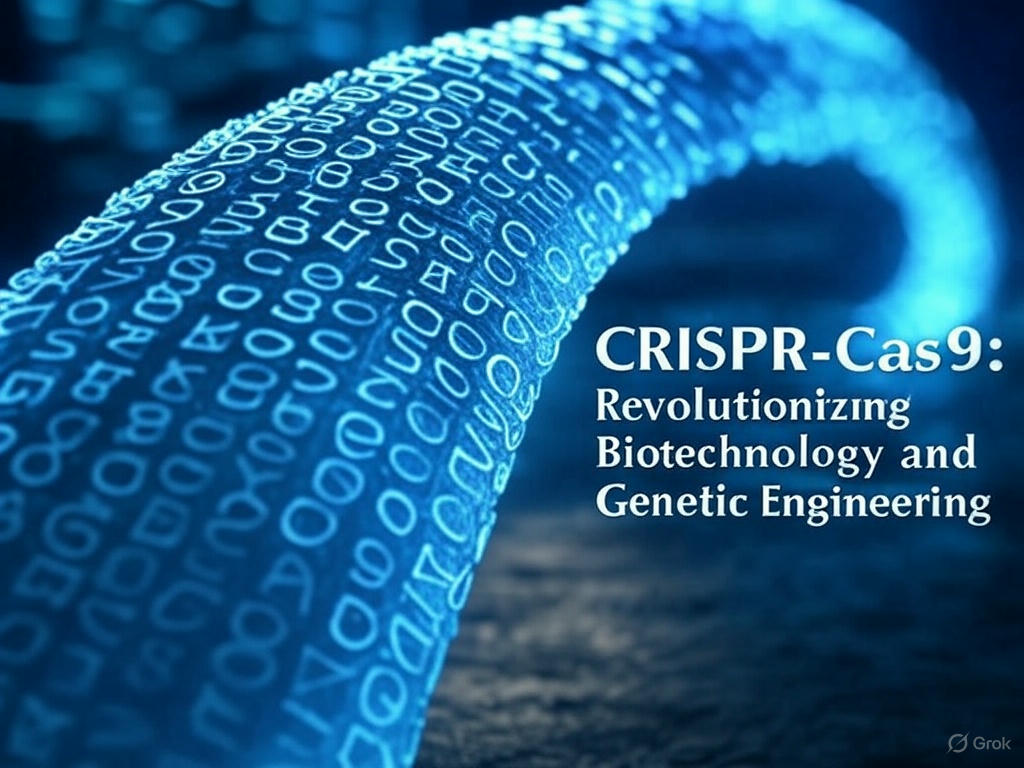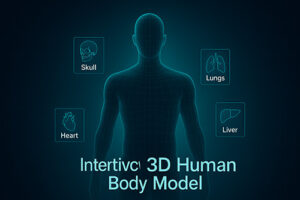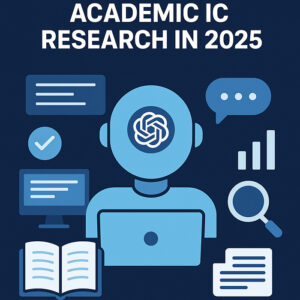CRISPR-Cas9: Revolutionizing Biotechnology and Genetic Engineering
Introduction: The Genetic Revolution at Our Fingertips
Imagine a world where genetic diseases are relics of the past, where crops withstand extreme weather conditions without failing, and where personalized medicine is the standard, not the exception. This isn’t science fiction—it’s the burgeoning reality shaped by CRISPR-Cas9, the revolutionary gene-editing technology that has transformed biotechnology and genetic engineering practically overnight.
Often described as “genetic scissors,” CRISPR-Cas9 allows scientists to edit DNA with unprecedented precision, ease, and affordability. Since its discovery as a genome editing tool in 2012, CRISPR has catalyzed a scientific revolution that promises to reshape medicine, agriculture, and our understanding of life itself.
In this comprehensive guide, we’ll explore how CRISPR-Cas9 fits within the broader landscape of biotechnology and genetic engineering, examine its groundbreaking applications, address the ethical questions it raises, and look toward the extraordinary future it might create.
What Are Biotechnology and Genetic Engineering?
Biotechnology Defined
Biotechnology encompasses the use of biological systems, organisms, or derivatives to develop products and processes for specific purposes. This interdisciplinary field merges biology with technology to harness cellular and biomolecular processes, creating solutions that improve our lives and environment.
Biotechnology operates across several distinct sectors:
- Red biotechnology focuses on medical applications and pharmaceuticals
- Green biotechnology centers on agricultural innovations and food production
- White biotechnology involves industrial processes and biomanufacturing
- Blue biotechnology explores marine applications and aquatic resources
The modern biotechnology era began in the 1970s with the development of recombinant DNA technology, allowing scientists to combine DNA from different species—a fundamental breakthrough that paved the way for today’s genetic engineering marvels.
Genetic Engineering Explained
Genetic engineering represents a subset of biotechnology that directly manipulates an organism’s genetic material. By altering the genetic code—the fundamental blueprint of life—scientists can add new traits or remove unwanted characteristics from plants, animals, and microorganisms.
The core techniques of genetic engineering include:
- Gene insertion – Adding new genes to an organism’s genome
- Gene deletion – Removing specific genes from DNA
- Gene silencing – Preventing certain genes from being expressed
- Gene editing – Making precise changes to existing genes
For decades, genetic engineering tools were cumbersome, expensive, and imprecise. The emergence of CRISPR-Cas9 technology has dramatically changed this landscape, democratizing access to gene editing and accelerating innovation across multiple fields.
The CRISPR-Cas9 Revolution
What is CRISPR-Cas9?
CRISPR-Cas9 is a gene-editing technology adapted from a natural defense system found in bacteria. In nature, bacteria use CRISPR (Clustered Regularly Interspaced Short Palindromic Repeats) and CRISPR-associated (Cas) proteins to protect themselves against viral infections by cutting up the DNA of invading viruses.
Scientists have repurposed this bacterial immune mechanism into a powerful gene-editing tool with two key components:
- The Cas9 enzyme – Acts as molecular scissors that can cut DNA at specific locations
- Guide RNA (gRNA) – Directs the Cas9 enzyme to the precise location in the genome that needs editing
This system allows researchers to:
- Cut DNA at virtually any predetermined site
- Remove unwanted genetic sequences
- Insert new genetic material
- Modify existing genes with remarkable precision
How CRISPR Works: A Step-by-Step Breakdown
Understanding CRISPR’s mechanism helps appreciate its revolutionary impact:
- Targeting – Scientists design a guide RNA (gRNA) that matches the DNA sequence they want to edit
- Recognition – The gRNA binds to the Cas9 enzyme, forming an active complex
- Binding – This complex locates and binds to the target DNA sequence
- Cutting – Cas9 creates a double-strand break in the DNA at the target site
- Repair – The cell’s natural repair mechanisms fix the break, either by:
- Non-homologous end joining (NHEJ) – Error-prone repair that can disable genes
- Homology-directed repair (HDR) – Precise repair using a template provided by researchers
The ability to harness the cell’s own repair mechanisms allows scientists to make specific changes to genes with unprecedented accuracy.
Why CRISPR Outperforms Previous Technologies
CRISPR-Cas9 represents a quantum leap over earlier gene-editing technologies like zinc finger nucleases (ZFNs) and transcription activator-like effector nucleases (TALENs):
| Feature | CRISPR-Cas9 | ZFNs/TALENs |
|---|---|---|
| Ease of use | Simple RNA programming | Complex protein engineering |
| Targeting flexibility | Can target almost any DNA sequence | Limited targeting options |
| Multiplexing | Can edit multiple genes simultaneously | Typically limited to one gene at a time |
| Cost | Hundreds of dollars | Thousands to tens of thousands |
| Time required | Days to weeks | Months |
| Success rate | Generally high | Variable |
This dramatic improvement in accessibility, cost, and efficiency has democratized gene editing, allowing more scientists to explore genetic solutions to pressing global challenges.
How Biotechnology and CRISPR Are Revolutionizing Various Industries
Healthcare Transformation
CRISPR-Cas9 is accelerating breakthroughs across medical research and treatment:
Gene Therapy Revolution
CRISPR has reinvigorated the field of gene therapy by offering new approaches to treating genetic disorders:
- Sickle Cell Disease – Clinical trials using CRISPR to correct the mutation in blood stem cells have shown promising early results
- Duchenne Muscular Dystrophy – Researchers are using CRISPR to remove or repair the defective dystrophin gene
- Hereditary Blindness – CRISPR-based treatments for Leber congenital amaurosis and other inherited retinal diseases are advancing to clinical testing
Cancer Treatment Innovations
CRISPR is enhancing cancer therapies through several approaches:
- CAR-T Cell Improvement – Using CRISPR to enhance engineered T-cells that target cancer
- Tumor Suppressor Restoration – Fixing mutated tumor suppressor genes like p53
- Personalized Cancer Therapy – Quickly testing cancer cells’ response to different drugs by using CRISPR to mimic patient-specific mutations in lab models
Infectious Disease Management
CRISPR technology offers new weapons against infectious diseases:
- Viral Disease Treatment – Directly targeting viral DNA/RNA, including potential therapies for HIV, herpes, and hepatitis B
- Rapid Diagnostics – CRISPR-based diagnostic tools that can detect pathogens with high sensitivity and specificity
- Antimicrobial Resistance – Developing new approaches to combat antibiotic-resistant bacteria
Drug Discovery Acceleration
CRISPR has transformed pharmaceutical research:
- High-throughput Screening – Rapidly testing thousands of gene variants to identify drug targets
- Disease Modeling – Creating more accurate human cell and animal models of diseases
- Target Validation – Confirming the role of specific genes in disease pathways
Agricultural Revolution
Biotechnology and CRISPR are reshaping farming and food production:
Crop Improvement
CRISPR enables precise crop modifications:
- Drought Resistance – Editing genes that control water usage and stress response
- Disease Resistance – Creating crops immune to common pathogens
- Nutritional Enhancement – Increasing vitamin content and other nutritional factors
- Yield Improvement – Modifying photosynthesis pathways to increase productivity
Animal Agriculture Advances
Livestock breeding and health have seen significant innovations:
- Disease Resistance – Developing pigs resistant to diseases like PRRS (Porcine Reproductive and Respiratory Syndrome)
- Allergen Elimination – Removing proteins that cause allergic reactions in consumers
- Improved Growth Efficiency – Enhancing feed conversion rates
- Animal Welfare – Breeding hornless cattle to eliminate painful dehorning procedures
Food Safety and Quality
Biotechnology enhances food system security:
- Extended Shelf Life – Reducing food waste through slower ripening fruits
- Allergen-Free Options – Removing common allergens from foods
- Mycotoxin Resistance – Protecting crops from fungal toxins
- Flavor and Texture Enhancement – Improving consumer experience while maintaining nutritional value
Environmental Applications
CRISPR and biotechnology offer powerful tools for environmental challenges:
Bioremediation
Using engineered organisms to clean contaminated environments:
- Plastic Degradation – Enhancing bacteria to break down persistent plastics
- Heavy Metal Removal – Organisms that can extract and concentrate toxic metals
- Oil Spill Cleanup – Accelerating natural hydrocarbon degradation
Conservation Biology
Protecting endangered species and ecosystems:
- Genetic Rescue – Restoring genetic diversity to endangered populations
- Disease Resistance – Protecting vulnerable species from pathogens
- Invasive Species Control – Developing gene drives to manage harmful invasive organisms
Climate Change Mitigation
Biological approaches to reducing greenhouse gas emissions:
- Carbon Sequestration – Engineering plants with enhanced carbon capture abilities
- Methane Reduction – Modifying cattle microbiomes to reduce methane emissions
- Alternative Protein Sources – Developing lab-grown meats and plant-based alternatives
Recent Breakthroughs in Genetic Engineering
CRISPR Innovations
The CRISPR platform continues to evolve with remarkable speed:
Base Editing
A refined version of CRISPR that changes individual DNA letters without cutting the double helix:
- Single Nucleotide Precision – Changing A•T to G•C pairs and vice versa
- Reduced Off-target Effects – Lower risk of unintended edits
- Applications in Point Mutations – Targeting diseases caused by single letter changes
Prime Editing
An even more versatile approach that acts like a genetic word processor:
- Search and Replace Capability – Finding and replacing specific DNA sequences
- Versatility – Can perform all types of edits (insertions, deletions, all 12 possible base-to-base conversions)
- No Double-Strand Breaks – Avoids many of the risks associated with traditional CRISPR
CRISPR Beyond Editing
The technology has expanded beyond DNA modification:
- Epigenetic Editing – Modifying gene expression without changing the DNA sequence
- RNA Editing – Targeting RNA instead of DNA for temporary modifications
- CRISPR Screening – Using CRISPR libraries to identify gene function across entire genomes
Gene Therapy Milestones
Recent years have seen historic approvals and breakthroughs:
| Therapy | Disease | Status | Mechanism |
|---|---|---|---|
| Luxturna | Inherited Retinal Dystrophy | FDA Approved (2017) | AAV vector delivering functioning RPE65 gene |
| Zolgensma | Spinal Muscular Atrophy | FDA Approved (2019) | AAV9 vector delivering SMN1 gene |
| Abecma | Multiple Myeloma | FDA Approved (2021) | CAR-T cell therapy targeting BCMA |
| CRISPR-based SCD therapy | Sickle Cell Disease | Late-stage trials | Ex vivo editing of patient stem cells |
These therapies represent just the beginning of a new era in medicine, with over 1,000 gene and cell therapy clinical trials currently underway worldwide.
Synthetic Biology Advances
Synthetic biology combines engineering principles with genetic research:
Genome Writing and Synthesis
Moving beyond editing to writing entire genomes:
- Synthetic Yeast Genome Project (Sc2.0) – Creating the world’s first synthetic eukaryotic genome
- Minimal Genomes – Reducing bacterial genomes to their essential components
- DNA Data Storage – Using synthesized DNA as a high-density information storage medium
Cell-Free Systems
Biological processes without using whole cells:
- Cell-Free Protein Synthesis – Producing proteins without living organisms
- Biosensors – Detecting environmental contaminants or pathogens
- Rapid Prototyping – Testing biological circuits without cell transformation
Engineered Metabolic Pathways
Programming cells to produce valuable compounds:
- Pharmaceutical Production – Microbes engineered to make medicines
- Sustainable Materials – Biological production of plastics, textiles, and construction materials
- Fine Chemicals – Enzymatic synthesis of complex molecules
Ethical Concerns and Controversies
Genetic Modification Debates
CRISPR technology has intensified longstanding debates:
Safety Considerations
Potential unintended consequences of genetic modifications:
- Off-target Effects – Unintended edits in non-target genes
- Mosaicism – When only some cells contain the intended edit
- Long-term Effects – Unknown consequences that may emerge over time
- Ecological Impacts – Potential disruption of ecosystems when modified organisms interact with wild populations
Access and Equity Issues
Questions about who benefits from these powerful technologies:
- Global Access Disparities – Potential to widen health and wealth gaps
- Intellectual Property Barriers – Patent landscapes that might restrict innovation
- Cost Considerations – Ensuring treatments are affordable and accessible
Regulation Challenges
Overseeing rapidly evolving technologies:
- Regulatory Frameworks – Many countries still developing appropriate oversight mechanisms
- International Harmonization – Differing approaches across national boundaries
- Risk Assessment Standards – Determining appropriate safety evaluations
Human Germline Editing
Modifications that can be inherited present unique ethical challenges:
The CRISPR Babies Controversy
In 2018, scientist He Jiankui announced the birth of twin girls with CRISPR-edited genomes:
- Global Condemnation – The scientific community universally criticized this premature application
- Regulatory Response – Prompted many countries to strengthen oversight
- Ethical Discussion – Intensified debate about appropriate boundaries
Therapeutic vs. Enhancement Applications
Distinguishing between medical necessity and human enhancement:
- Disease Prevention – Eliminating heritable genetic disorders
- Non-medical Traits – Concerns about selecting for traits like height or intelligence
- Defining Boundaries – The blurry line between treatment and enhancement
Intergenerational Consequences
The permanent nature of germline modifications:
- Unanticipated Effects – Potential impacts that might not be apparent for generations
- Consent Issues – Future generations cannot consent to modifications
- Cultural and Social Impacts – Potential changes to human diversity and social structures
Bioethics Frameworks
Various approaches guide ethical decision-making:
Precautionary Principle
Proceeding with caution when risks are uncertain:
- Burden of Proof – Requiring demonstration of safety before proceeding
- Reversibility – Preference for changes that can be undone
- Risk Assessment – Thorough evaluation of potential harms
Principles-Based Ethics
Applying established ethical principles:
- Autonomy – Respecting individual choice
- Beneficence – Ensuring benefits outweigh risks
- Justice – Fair distribution of benefits and burdens
- Non-maleficence – Avoiding harm
Governance Models
Approaches to collective decision-making:
- Scientific Self-regulation – The scientific community setting standards
- Government Oversight – National and international regulatory frameworks
- Public Engagement – Involving broader society in determining acceptable uses
Future of Biotechnology: Trends and Innovations
Emerging Technologies
Several cutting-edge approaches promise to expand CRISPR’s impact:
In Vivo Gene Editing
Directly editing genes within the body:
- Delivery Innovations – New methods to deliver CRISPR components to specific tissues
- Targeted Applications – Focusing on organs like liver, eye, and brain
- Reduced Intervention – Eliminating the need to remove and reintroduce cells
Multiplexed Editing
Making multiple changes simultaneously:
- Complex Disease Targeting – Addressing conditions with multiple genetic factors
- Synthetic Biology Applications – Creating novel biological pathways
- Accelerated Research – Faster development of cell and animal models
RNA Editing
Temporary modifications without changing DNA:
- Reversible Interventions – Changes that don’t permanently alter the genome
- Protein Modulation – Altering protein levels without affecting the gene
- Safety Advantages – Reduced risk of permanent off-target effects
Convergence with Other Fields
CRISPR’s integration with other technologies creates powerful synergies:
AI and Machine Learning
Computational approaches enhancing genetic research:
- Guide RNA Design – Optimizing CRISPR targeting accuracy
- Prediction of Off-target Effects – Identifying potential unintended edits
- Target Discovery – Finding the most promising genetic targets for intervention
Single-Cell Technologies
Analyzing and editing at the individual cell level:
- Single-Cell Sequencing – Understanding cellular heterogeneity
- Precise Cellular Targeting – Editing specific cell populations
- Development Tracking – Following genetic changes through cell lineages
Nanotechnology
Precise delivery systems for genetic tools:
- Nanoparticle Delivery – Enhanced targeting of specific tissues
- Controlled Release – Timing the delivery of CRISPR components
- Sensing and Feedback – Monitoring the effects of genetic modifications in real time
Future Applications
The coming decades may see breakthroughs in:
Precision Medicine Revolution
Tailoring treatments to individual genetic profiles:
- Genetic Risk Prediction – Identifying disease susceptibilities early
- Pharmacogenomic Optimization – Matching medications to genetic variants
- Regenerative Medicine – Repairing damaged tissues using gene-edited stem cells
Novel Therapeutics
New approaches to disease treatment:
- Gene Drive Therapies – Ensuring therapeutic genes spread through cell populations
- Living Medicines – Engineered cells that perform therapeutic functions
- Continuous Treatment Systems – Implantable devices that produce therapeutic proteins
Climate and Sustainability Solutions
Biological approaches to environmental challenges:
- Engineered Photosynthesis – More efficient carbon capture in plants
- Nitrogen Fixation in Non-legumes – Reducing fertilizer requirements
- Bio-based Materials – Sustainable alternatives to petroleum products
Practical Applications and Case Studies
Medical Breakthroughs
CRISPR Therapy for Sickle Cell Disease
One of the first CRISPR therapies to reach advanced clinical trials:
- Approach: Editing patient’s stem cells to produce fetal hemoglobin
- Results: Early trials showing sustained elimination of painful crises
- Impact: Potential cure for a disease affecting millions worldwide
- Challenges: Accessibility and cost of specialized treatment
CRISPR-Based Diagnostics
Rapid disease detection using CRISPR technology:
- SHERLOCK and DETECTR Platforms: Utilizing Cas proteins for pathogen detection
- Applications: COVID-19 testing, cancer biomarker detection
- Advantages: Point-of-care testing with high sensitivity and specificity
- Future Potential: Expanded use in resource-limited settings
Agricultural Applications
Non-Browning Mushrooms
The first CRISPR-edited food to receive USDA clearance:
- Modification: Deletion of genes producing enzymes that cause browning
- Benefit: Reduced food waste and longer shelf life
- Regulatory Significance: Approved without the regulations applied to traditional GMOs
- Market Impact: Demonstrating consumer acceptance of precisely edited foods
Disease-Resistant Cacao
Protecting chocolate production from devastating pathogens:
- Challenge: CRISPR editing of cacao to resist pathogens like Phytophthora
- Approach: Targeting susceptibility genes without affecting quality
- Potential Impact: Securing a crop crucial to millions of smallholder farmers
- Status: Research stage with field trials in development
Industrial and Environmental Applications
Engineered Bacteria for Plastic Degradation
Addressing plastic pollution through biotechnology:
- Innovation: CRISPR-modified bacteria that can break down PET plastic
- Mechanism: Enhanced production of PETase enzymes
- Scale Potential: From laboratory to industrial application
- Challenges: Ensuring containment and environmental safety
Bio-manufactured Materials
Sustainable production of high-value materials:
- Spider Silk Production: Engineered microbes producing this ultra-strong protein
- Applications: Medical sutures, protective gear, textiles
- Advantages: Reduced environmental impact compared to synthetic materials
- Commercialization: Moving from research to market applications
Frequently Asked Questions
How does CRISPR gene editing work?
CRISPR gene editing works through a two-component system:
- The Cas9 enzyme acts as molecular scissors that can cut both strands of DNA at a specific location.
- A guide RNA directs Cas9 to the precise location in the genome that needs editing by matching the target DNA sequence.
When the cut occurs, the cell’s natural repair mechanisms fix the break, either by:
- Joining the cut ends together (often introducing small errors that can disable a gene)
- Using a supplied DNA template to make more specific changes
This process allows scientists to disable genes, correct mutations, or insert new genetic sequences with remarkable precision.
Is CRISPR technology safe?
The safety of CRISPR technology depends on its specific application:
- Research applications: Generally considered safe with proper laboratory controls
- Medical treatments: Undergoing rigorous clinical trials to establish safety profiles
- Agricultural use: Subject to regulatory evaluation before commercial release
Key safety considerations include:
- Off-target effects: Unintended edits at similar DNA sequences
- Mosaicism: When edits occur in some but not all cells
- Immune responses: Potential reactions to the CRISPR components
- Long-term effects: Some impacts may not be immediately apparent
The scientific community continues to improve CRISPR’s specificity and develop methods to detect and minimize unintended effects.
What is the difference between CRISPR and older genetic engineering techniques?
CRISPR represents a significant advance over previous methods:
| Aspect | CRISPR | Older Methods (ZFNs, TALENs, etc.) |
|---|---|---|
| Programmability | Uses RNA to target DNA (easy to design) | Requires complex protein engineering |
| Precision | Highly specific with improving accuracy | Variable specificity |
| Efficiency | High success rates for edits | Often lower efficiency |
| Multiplexing | Can edit multiple sites simultaneously | Usually limited to single edits |
| Cost | Hundreds to thousands of dollars | Tens of thousands of dollars |
| Accessibility | Widely available to researchers | Required specialized expertise |
| Speed | Days to weeks for new targets | Months for new targets |
These advantages have dramatically accelerated the pace of genetic research and expanded the range of possible applications.
How is CRISPR being used to fight diseases?
CRISPR approaches to disease treatment fall into several categories:
- Ex vivo therapy: Cells are removed from the patient, edited, and returned
- Examples: Sickle cell disease, beta-thalassemia, certain cancers
- In vivo therapy: CRISPR components are delivered directly to cells within the body
- Examples: Inherited eye diseases, liver disorders, muscular dystrophy
- CRISPR-based diagnostics: Using CRISPR to detect disease-causing pathogens or genetic variations
- Examples: COVID-19 testing, cancer biomarker detection
- Disease prevention: Targeting disease vectors
- Example: Gene drives in mosquitoes to prevent malaria transmission
Current clinical trials focus primarily on genetic diseases with well-understood single-gene causes, cancers, and infectious diseases like HIV.
Will CRISPR lead to designer babies?
The potential for using CRISPR to create “designer babies” remains technically possible but faces significant barriers:
Technical challenges:
- Many desired traits are influenced by hundreds or thousands of genes
- Our understanding of complex genetic interactions remains limited
- Current techniques have limitations in efficiency and safety
Regulatory restrictions:
- Most countries prohibit or strictly regulate human germline editing
- International scientific consensus opposes heritable human genome editing for enhancement
Ethical concerns:
- Questions about consent of future generations
- Potential for increasing social inequality
- Unpredictable long-term consequences
While the 2018 birth of CRISPR-edited twins in China demonstrated that some individuals might proceed despite these barriers, the global scientific community continues to advocate for careful, ethical advancement of the technology with appropriate oversight.
Is CRISPR-edited food safe to eat?
Current scientific consensus indicates that CRISPR-edited foods are as safe as conventionally bred foods when:
- The edits make small, precise changes similar to those that could occur naturally
- No foreign DNA is introduced into the organism
- The edited traits are well-characterized and understood
Regulatory approaches vary by country:
- United States: Many CRISPR-edited crops are not subject to special regulation if they could have been developed through traditional breeding
- European Union: Applies GMO regulations to gene-edited crops
- Japan: Evaluates CRISPR-edited foods case-by-case with lighter regulation than traditional GMOs
Each CRISPR-edited food must be evaluated individually, considering the specific changes made and potential impacts on:
- Allergenicity
- Toxicity
- Nutritional composition
- Environmental interactions
Conclusion: Navigating Our CRISPR Future
CRISPR-Cas9 technology represents one of the most powerful tools humans have ever developed—a technology that allows us to rewrite the very code of life itself. From treating previously incurable diseases to developing climate-resilient crops, CRISPR’s potential to address global challenges seems limited only by our imagination and wisdom.
As with any transformative technology, CRISPR’s greatest promise comes with significant responsibility. The ability to make permanent, heritable changes to the genetic code of living organisms demands thoughtful governance, inclusive conversation, and careful consideration of both intended and unintended consequences.
The coming decades will likely see an explosion of CRISPR applications across medicine, agriculture, and environmental management. These developments may fundamentally change our relationship with the natural world and ourselves. The pace of innovation shows no signs of slowing, with new CRISPR variants and applications emerging regularly.
The CRISPR revolution isn’t just for scientists—it’s reshaping our world in ways that affect everyone. Understanding this technology and participating in conversations about its appropriate use represents an important form of scientific citizenship in the 21st century.
Call to Action
To stay informed and engaged with this rapidly evolving technology:
- Educate yourself about CRISPR and genetic engineering through resources from reputable organizations like the National Human Genome Research Institute or the Innovative Genomics Institute
- Follow developments in the field through science news sources dedicated to accurate reporting
- Participate in public discussions about biotechnology policy and regulation
- Consider the implications of these technologies for healthcare, food systems, and the environment
- Support responsible research that balances innovation with appropriate safeguards
The CRISPR revolution has just begun, and its ultimate impact will depend on how we collectively choose to harness its extraordinary potential. By understanding both the promise and challenges of this technology, we can help guide its development toward the greatest benefit for humanity and our planet.
<!– Schema Markup for SEO –> <script type=”application/ld+json”> { “@context”: “https://schema.org”, “@type”: “Article”, “headline”: “CRISPR-Cas9: Revolutionizing Biotechnology and Genetic Engineering”, “description”: “A comprehensive guide to CRISPR-Cas9 technology and its revolutionary impact on biotechnology, medicine, agriculture, and environmental conservation.”, “image”: “https://example.com/crispr-technology-image.jpg”, “author”: { “@type”: “Organization”, “name”: “Research.Help” }, “publisher”: { “@type”: “Organization”, “name”: “Research.Help”, “logo”: { “@type”: “ImageObject”, “url”: “https://example.com/logo.jpg” } }, “datePublished”: “2025-03-12”, “dateModified”: “2025-03-12” } </script> <!– Image Optimization Notes –> <!– Main Featured Image: – Filename: crispr-cas9-gene-editing-header.jpg – Alt text: “CRISPR-Cas9 gene editing technology visualized with DNA double helix” – Size: 1200x630px for optimal social sharing – Format: WebP with JPEG fallback – Compress to <100KB without quality loss Section Images: 1. CRISPR Mechanism Image – Alt text: “Illustration of CRISPR-Cas9 mechanism cutting DNA at targeted location” 2. Medical Applications Image – Alt text: “Scientist using CRISPR technology for gene therapy research” 3. Agricultural Applications Image – Alt text: “CRISPR-edited crops showing enhanced growth and resistance” 4. Ethical Considerations Image – Alt text: “Global discussion on ethical implications of CRISPR gene editing technology” –>









